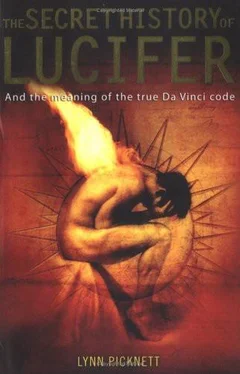33. Mark 14:3-5.
34. Luke 7:36-50.
35. Mark, 14:6-8.
36. Ibid., 14:9.
37. John 12:1-8.
38. Luke 7:36-50.
39. Peter Redgrove, The Black Goddess and the Sixth Sense, London, 1989, pp. 125-6.
40. Ibid.
41. Acts 2:17.
42. See Picknett, pp. 61-2, 64-6, 82, 147, 231.
43. Luke 8:1-2.
44. Ibid., 8:3.
45. See David Ayerst and A.S.T. Fisher, Records of Christianity, Volume 1: In the Roman Empire, Oxford, 1971, pp. 144-6.
46. Cyril of Jerusalem, Catechetical Lectures, 4.36.
47. David Tresemer and Laura Lea Cannon, Introduction to Jean-Yves Leloup's translation of The Gospel of Mary Magdalene, Rochester, Vermont, 2003, p. xi. Their own reference is given as `James Carroll, Constantine's Sword, New York, Houghton Mifflin, 2001.'
48. The Pistis Sophia, translated by G.R.S. Mead, Kila, MT, USA, 1921, Second Book, 72:3.
49. G. R. S. Mead, Pistis Sophia, Kila, MT, USA, 1921, Second Book, 160.
50. For example, see Luke 4:38-9, in which Simon's mother-in-law is healed by Jesus. `Peter' was Simon's nickname, meaning `rock'. It has been suggested by Michael Baigent and Richard Leigh that it may have been the equivalent of Sylvester Stallone's `Rocky' - expressing Simon's rough side.
51. Mead, Book Five.
52. Mark 16:9.
53. Luke 8:3.
54. Ibid., 12:27.
55. Susan Haskins, Mary Magdalen, London, 1993, Chapter III.
56. Leloup, 10:5.
57. Ibid., p. 37 (p. 17 of the original text).
58. Ibid., p. 39 (p. 18 of original text).
59. Pistis Sophia, First Book, 36.
60. Ibid., Second Book, 72: 3.
61. Ibid.
62. Ibid., 28.
63. Picknett, pp. 67-8.
64. 1 am indebted to Clive Prince for a fruitful discussion on this subject, and for the `office' analogy.
65. Morton Smith, Jesus the Magician, London, 1978, p. 25.
66. Picknett and Prince, 112-13; Picknett 39-4 1.
67. Che non ha potesta in un medesimo tempo di dire diverse cose.
68. Lynn Picknett and Clive Prince, Turin Shroud: How Leonardo da Vinci Fooled History, London, 2000, p. 194.
69. Timothy Freke and Peter Gandy, Jesus and the Goddess: The Secret Teachings of the Original Christians, London, 2001, p. 45. See also www.BelovedDisciple.org.
70. Ibid.
71. John 14:23.
72. See www.BelovedDisciple.org.
73. Ibid.
74. John 19:25.
75. Jusino's website.
76. Leloup, p. 37 (p. 17).
77. Layton, Gospel of Thomas, 114:18-20.
78. Ibid., Gospel of Philip, 48.
79. John 13:23-26.
80. Ibid., 18:15-16.
81. Ibid., 20:2-10.
82. Ibid., 21:7.
83. Ibid., 21:20-23.
84. See Desmond Stewart's The Foreigner, London, 1981, p. 108.
85. Mark 10:46.
86. Luke 7:44-47.
87. See Picknett and Prince, Chapter One: `The Secret Code of Leonardo da Vinci', and Picknett, Chapter One, `The Outsiders'.
88. In the Sainsbury Wing of the National Gallery, Trafalgar Square, in central London.
89. Luke 7:19.
90. John 1:28. Of John's alleged declaration that he was not the Christ, this passage reads: `This all happened at Bethany at the other side of the Jordan', (My emphasis). Perhaps this comes into the category of `protesting too much'.
91. G.R.S. Mead, `Simon Magus: An Essay', London, 1892, p. 10.
92. Picknett and Prince, p. 417.
93. Andre Nataf, The Wordsworth Dictionary of the Occult, trans., John Davidson, London, 1994, p. 182. Originally published in Paris, 1988, as Les maitres de l'occultisme.
94. Ibid.
95. Rollo Ahmed, The Black Art, London, 1936, p. 53.
96. Walker, p. 938.
97. Mead, p. 10.
98. Ibid., pp. 28ff.
99. Karl W. Luckert, Egyptian Light and Hebrew Fire, New York, 1991, p. 299.
100. Ibid., 305.
101. Quoted in Mead, p. 19.
102. Francis X. King, ed. Crowley on Christ, London, 1974, p. 15.
103. Luke 7: 28 and Matthew 11:11.
104. This passage appears in the otherwise lost Gnostic Gospel of the Egyptians. However, we are indebted to Clement of Alexandria who once again innocently included a quotation from this text in his Stromateis.
105. Layton, Gospel of Thomas, 61:23-33.
106. Walker, p. 885.
107. Matthew 11:3.
108. Ibid., 11:2.
109. Ibid., 11:9.
110. Ibid., 11:11.
111. Mark 14: 14.
112. Carl H. Kraeling, John the Baptist, London, 1951, p. 160.
113. Irenaeus, Adv. Haer. Book I. XIII.
114. A Muslim taxi driver told me that Islamic mystics traditionally fast and pray in the desert for 40 days, after which they have the power to summon and use djinns as their occult slaves. Although the average Muslim is wary of such practices, apparently this is not seen as evil.
115. Morton Smith, Jesus the Magician, London, 1978, p. 42.
116. Barbara Thiering, Jesus the Man, pp. 84-5 and 390-1.
117. Jeffrey Burton Russell, Lucifer: The Devil in the Middle Ages, (New York), 1984, p. 307.
Chapter Four Synagogues of Satan
1. Jean Markale, Montsegur and the Mystery of the Cathars, trans. Jon Graham, 2003. Originally Montsegur et l'enigme cathare, Paris, 1986, p. 66.
2. For a detailed background to the Cathars, see Markale; Yuri Stoyanov, The Hidden Tradition in Europe, London, 1994; Lynn Picknett, Mary Magdalene: Christianity's Hidden Goddess, London, 2003, and Lynn Picknett and Clive Prince, The Templar Revelation, London, 1997.
3. The Cathars only ate fish because they believed that fish procreated asexually.
4. Markale, p. 173.
5. Ibid., p. 176.
6. See Picknett, p. 184.
7. The reasoning behind this was that as God had given humanity dominion over all the animals, it was blasphemy not to reinforce that superiority by eating them. It is significant that to this day, among all the countries of Europe, it is the Catholic lands that have the worst reputation for animal welfare.
8. At Beziers, 20,000 townspeople willingly died at the hands of the Crusaders rather than renounce their belief that Jesus and the Magdalene were lovers. It is all the more remarkable because this is not a belief that would naturally appeal to Cathars and therefore is unlikely for them to have invented. Presumably they learnt it from a secret gospel similar to those found at Nag Hammadi in 1945.
9. Markale, p. 160.
10. See Picknett, pp. 91, 93-7, 196, 215-16, 221, 232-3 and de Voragine, pp. 153-5.
11. Montague Summers, The History of Witchcraft, London, 1926, p. 23.
12. Yuri Stoyanov, The Hidden Tradition in Europe, London, 1994, p. 189.
13. Ibid.
14. According to Jean Markale, Rahn was discovered faking some inscriptions and was duly punched on the nose by an outraged local historian!
15. It must be remembered that Rahn was a Nazi, although his earlier research in the Languedoc was relatively untouched by his later unpleasant ideology. His theses are included here in the spirit of Lucifer - i.e., fearlessly citing any interesting research no matter what its source rather than throw the politically correct baby out with the bathwater. After all, on certain points, he may have been correct!
16. Otto Rahn, Luzifers Hofgesind: Eine Reize zu den guten Geistern Europas, 1937, tranlated into the French as La Cour de Lucifer: Voyage au coeur de la plus haute spiritualite europeene, Paris, 1994. I am greatly indebted to Clive Prince for his hard work in translating key passages from the French for me.
17. For an in-depth examination of the history and beliefs of the Templars, see Picknett and Prince.
18. Of course as a Nazi, Rahn would have infinitely preferred a great religion to have Nordic or Germanic rather than Middle Eastern (Semitic) roots.
19. Rahn, p. 15 of the Introduction to the French edition by Arnaud d'Apremont, translated by Clive Prince.
20. Ibid.
21. Ibid.
Читать дальше












